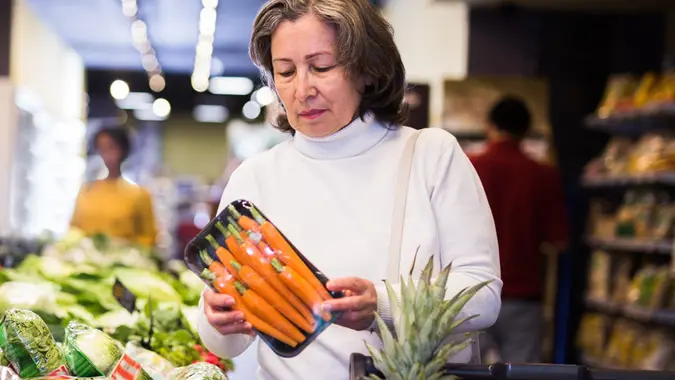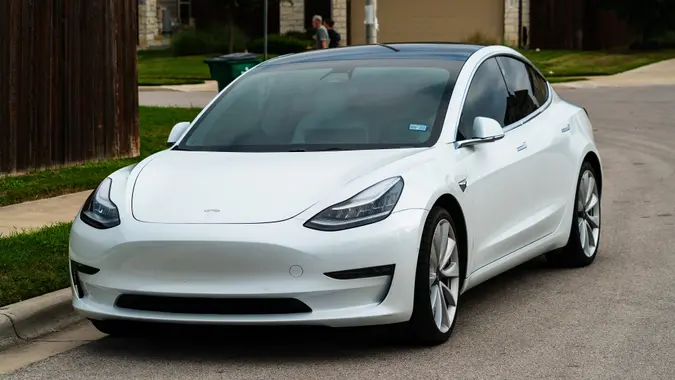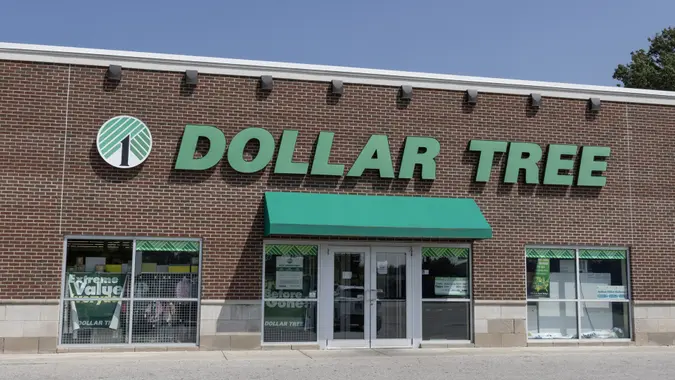7 Sneaky Ways Tariffs Have Hit Your Favorite Grocery Store

Commitment to Our Readers
GOBankingRates' editorial team is committed to bringing you unbiased reviews and information. We use data-driven methodologies to evaluate financial products and services - our reviews and ratings are not influenced by advertisers. You can read more about our editorial guidelines and our products and services review methodology.

20 Years
Helping You Live Richer

Reviewed
by Experts

Trusted by
Millions of Readers
When most people think about tariffs, they imagine extra fees on imported goods or headlines about trade wars; not something that affects their weekly Costco run or Walmart pickup order. But here’s the truth: Those tariffs have quietly made their way into your grocery cart in more ways than one.
Even when big retailers like Costco, Walmart and Sam’s Club say they’re doing everything they can to avoid raising prices, the ripple effects of tariffs still show up behind the scenes. It can show up in how products are packaged, shipped and even powered.
Let’s take a look at some of the sneaky ways tariffs have hit your favorite stores (and, unfortunately, your wallet).
1. Canned-Goods Costs Climbed Because Metal Got Pricier
Remember when canned goods were the ultimate budget-friendly pantry staple? Tariffs on steel and aluminum have made those cans more expensive to produce.
One analysis from the American Action Forum found canned-food inflation accelerated after the 2018 metal tariffs, with prices rising 5.2% in 2019 versus 1.4% the prior year, illustrating how tariff costs filter through with a lag.
Costco, Walmart and Sam’s Club sell a large volume of private-label and national-brand canned goods. That means items like beans, soups and tuna now cost a little more, even if the product inside hasn’t changed one bit.
2. Checkout-Line Delays You Feel But Don’t See
Most people don’t realize that tariffs have also messed with how stores get their products in the first place. Back in 2021, the U.S. slapped steep tariffs on Chinese-made container chassis (the wheeled frames used to haul shipping containers), according to the Federal Register.
The result? Fewer chassis, longer wait times and higher transportation costs for companies that rely on constant inventory restocks (ahem, every grocery chain ever). When shipping gets more expensive, so does everything inside those containers from produce to paper towels.
3. Energy and Infrastructure Projects Got Costlier
Costco and Walmart are both huge on renewable energy. Many of their warehouses are lined with solar panels, per Reuters, to help offset high electricity costs. But tariffs on imported solar panels have made those clean-energy investments more expensive, delaying some projects and forcing stores to rely more on traditional power sources.
That means higher utility bills for massive stores that need to keep lights, freezers and A/C running all day, and higher operating costs can eventually show up in retail prices.
4. Even Pallets and Store Shelves Got Pricier
Tariffs on Canadian lumber didn’t just affect homebuilders. They hit retailers, too. Everything from wooden pallets that move products around warehouses to the wood fixtures and shelving in stores became more expensive.
Those hidden costs may not be obvious to shoppers, but when pallets, shipping crates and even display materials go up in price, retailers have to find a way to cover the difference. This difference is usually made by trimming deals or raising prices ever so slightly.
5. Tariffs Are Hiding in the Lighting and Store Equipment, Too
LED bulbs, fixtures and replacement parts are often imported, and many of them were hit with tariffs under the Section 301 actions against China. For stores that rely on massive warehouses, parking lots and refrigerator lighting, those extra costs add up fast. When maintaining or upgrading store equipment costs more, that leaves less wiggle room for price drops or big sales.
6. Tariffs Have Reshaped What’s in the Seafood Case (and What It Costs)
Seafood is one of the most tariff-sensitive grocery categories because so much processing happens in China, even for fish harvested elsewhere. Section 301 tariffs covered a wide range of seafood products, while the U.S. Trade Representative (USTR) has periodically extended (or let lapse) exclusions. When those imports were hit with tariffs, prices crept up for retailers and shoppers alike.
That’s one reason why you may have noticed seafood prices fluctuate more often lately or why your favorite brand keeps disappearing from shelves.
7. Membership Stores Are Feeling It in Unexpected Places
For stores like Costco and Sam’s Club, groceries aren’t the only way they make money. They also rely on sales from electronics, home goods and other general merchandise to help offset food prices. When tariffs hit those non-food items, it can squeeze profits and make it harder to keep grocery prices low.
So, even if your rotisserie chicken is still $4.99 (thank you, Costco!), something else in the store may quietly go up to make up the difference.
Tariffs may sound like something that only affects international trade, but their impact trickles down to the everyday shopper — sometimes in ways you’d never expect. From higher costs to run stores to subtle changes in product offerings, tariffs have a way of sneaking into your grocery budget even when prices look stable.
So next time you notice your favorite canned soup costs a few cents more or that seafood sale isn’t as good as last year’s, there’s a good chance tariffs are playing a hidden role.
 Written by
Written by  Edited by
Edited by 

























